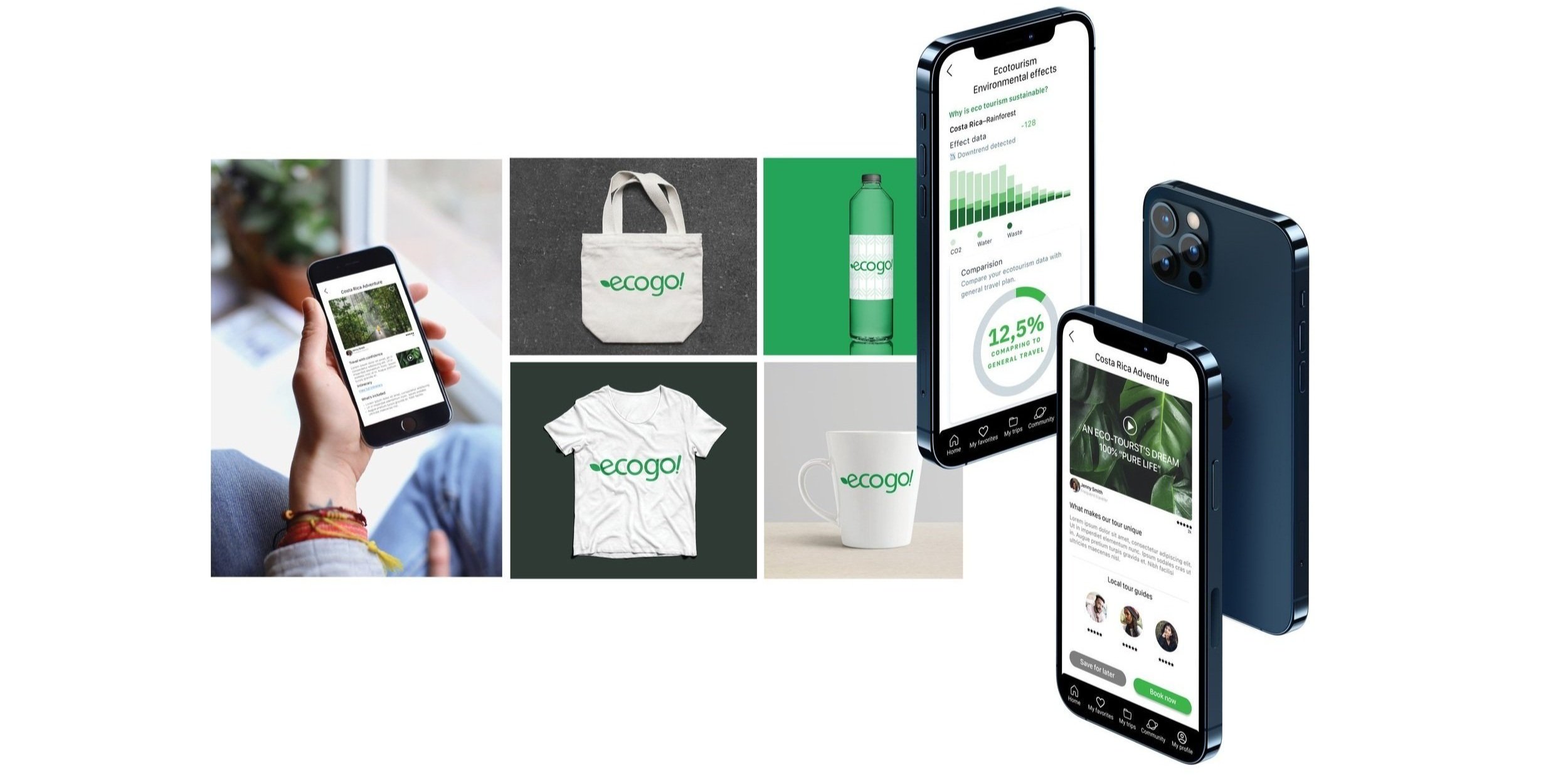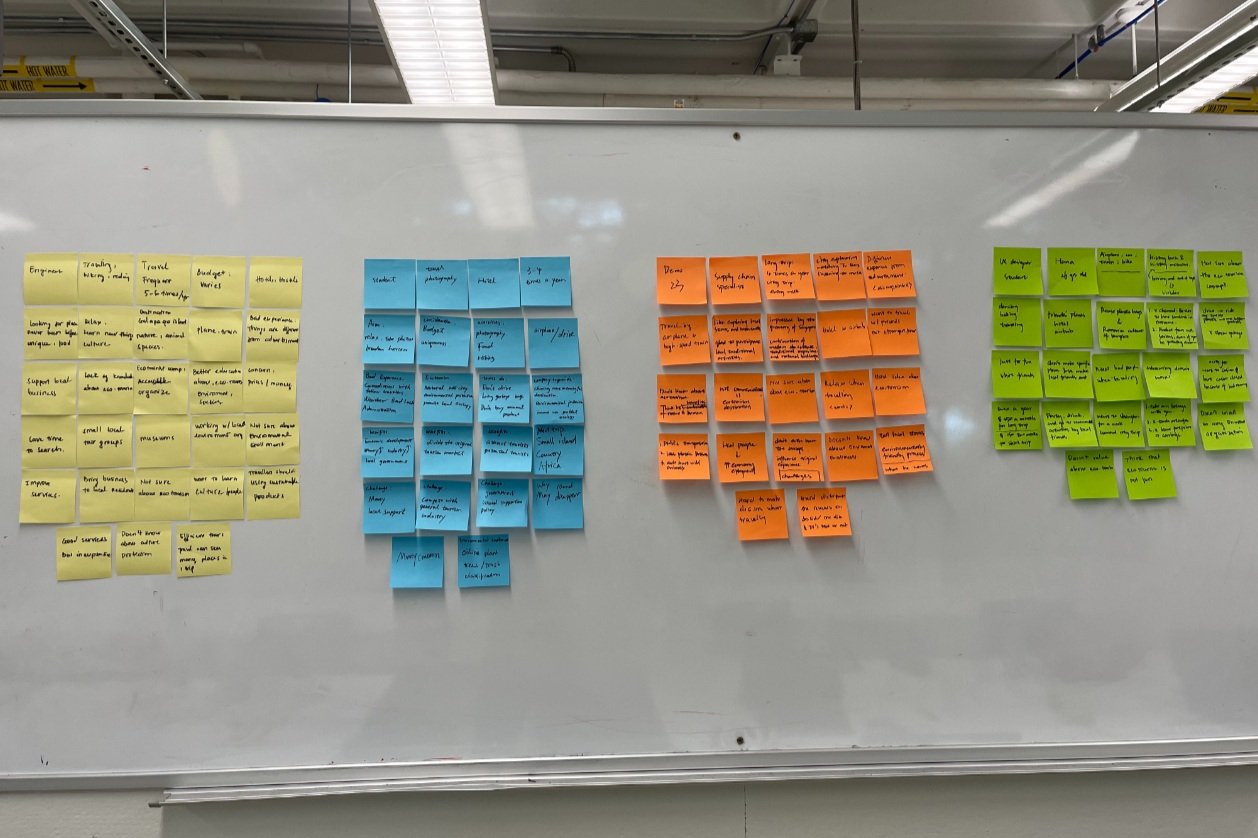
Ecogo Case Study
Overview
About
Ecogo is an app that helps travelers who are tired of ordinary trips pursue a more involved sustainable travel experience. The goal of this project was to design an ecotourism service that provides users eco-friendly trips which connect users with the environment and culture.
My Role
This is a group project. I worked with two other teammates. My role focused on:
User Research and Analysis
Product Strategy
Persona Creation
Branding
Wireframing
User Interface Designer and Prototyping
Usability Testing
Duration
3.5 month project
The Process
Research and Problem Definition
SECONDARY RESEARCH
So… What is ecotourism?
Ecotourism is now defined as “responsible travel to natural areas that conserves the environment, sustains the well-being of the local people, and involves interpretation and education”(TIES, 2015). Education is meant to be inclusive of both staff and guests.
Principles of Ecotourism
Ecotourism is about uniting conservation, communities, and sustainable travel. This means that those who implement, participate in and market ecotourism activities should adopt the following ecotourism principles (Kern River Conservancy):
Minimize physical, social, behavioral, and psychological impacts.
Build environmental and cultural awareness and respect.
Provide positive experiences for both visitors and hosts.
Provide direct financial benefits for conservation.
Generate financial benefits for both local people and private industry.
Deliver memorable interpretative experiences to visitors that help raise sensitivity to host countries’ political, environmental, and social climates.
Design, construct and operate low-impact facilities.
Recognize the rights and spiritual beliefs of the Indigenous People in your community and work in partnership with them to create empowerment.
Ecosystem Map
To understand the subject matter, we analyzed and created the ecosystem map to better visualize its operational system.
Value Creation
We analyzed two companies: Urban Adventures and Adventures Tours Australia. We focused on analyzing key value creation tactics, the absence of key value creation tactics, and possible innovation areas.
Urban Adventures
KEY VALUE CREATION TACTICS
Brand — The company has a set value of "responsible tourism" which means they make sure that the company is not only focused on growing their business but also providing quality tours led by members of the local community. For instance, many tours focus on local resources, shops, and restaurants. This helps customers connect to the place and its people, but also helps to support and grow the local community by bringing them new business opportunities. Other than that, the company is run in conjunction with local NGOs, non-profits, and accelerators around the world. "Local know" is their brand promise.
Customer engagement — Urban Adventures offers a unique identity in terms of immersing the customers in the community, helping them learn about cultures, local activities, and local resources. They also create online experiences to engage customers in hands-on cooking classes, yoga, art, and virtual city walks.
Network — The company works with other firms and collaborators. They work with non-profit organizations such as NGOs, Intrepid Foundation, etc., and support a wide range of projects in areas of human rights, child protection, environment conservation, wildlife protection, and education. They also support projects that promote responsible tourism, sustainable development, green cities, and sustainable living. They collaborate with local businesses to make a connection between customers and communities.
THE ABSENCE OF KEY VALUE CREATION TACTICS
Process — The company does have some management on localizations, but the whole system still lacks strategy like employing a purposeful approach that manifests itself consistently across offerings, brands, and experiences.
Channel — There isn't any specific channel that can deliver products to the customer as the product of this company is mainly a unique travel experience that comes from local culture and businesses. The company did not do the product experience that could only be done in the company's proprietary channels.
POSSIBLE INNOVATION AREAS
Process — From a customer's perspective, we can easily divide it into stages. When we look at the purchase decision stage, we can find that customers mainly start their journey with Urban Adventure. But there seems to be less guidance and support through the decision-making process while looking through the website. Although Urban Adventure has a local service system in their travel destinations, it can still provide travel-related service before and after travel, like pre-departure guidance, group kick-off or previous experience sharing, and sharing and reward mechanisms.
Combination of network and channel — Since Urban Adventure has already established a strong network with different NGOs, local stores, and other organizations, they can transfer these collaborators into their channels at the same time. To be more specific, they could advertise for each other or initiate some events together to help with brand image establishment or customer acquisition for both sides. Additionally, Urban Adventure can keep exploring and developing new network approaches, including scheming special projects with celebrities, designing co-branded sustainable or cultural products with traditional big brands, and developing new media advertisements on platforms like Facebook or Twitter.
Service — There are no guarantees to assure the quality of the tours. They could develop a system that makes sure their customers were satisfied and happy with their tours.
Adventure Tours Australia
KEY VALUE CREATION TACTICS
Brand — The company is trying to create a brand that offers expert guides, exclusive accommodation, and an environmental focus. They also offer flight and tour packages to enhance customer experiences; this helps them grow globally. What makes them different and unique is that they offer theme tours focused on cultural experiences and their goal is creating environmentally aware tourism.
Customer engagement — To keep customers engaged with the company, they offer multiple trip discounts and allow the customer to customize their tour to show that they accommodate customer needs.
Network — The company partners with Aboriginal communities to educate their customers about the land and its significance to its traditional owners. They try to create cultural experiences but in a low-impact and culturally-sensitive way. They also connect with local communities.
Service — To make sure their customers are happy about their service and that their needs were taken care of, they provide talk-to-an-expert services and solicit customer feedback.
THE ABSENCE OF KEY VALUE CREATION TACTICS
Channel — The company still does little on improving the selling of their products like opening flagship stores or holding marketing activities focused on their brand. More work should be done to promote special channels to sell their products.
Profit Model — Few things are mentioned on the company's website about the costs of the various trips so it is difficult to interpret their business model and how they make profits.
POSSIBLE INNOVATION AREAS
Channel — Just like Urban Adventure, Adventure Tours Australia also needs improvement in the channel. They could employ a series of on-site stores or service stations. Also, new media platforms and related collaborators are also important to create new channels for the company to improve its brand reputation and attract more customers
Profit Model — Adventure Tours Australia depends primarily on its travel service. However, it is susceptible to changes in customer sentiment but also emergency situations like COVID-19. To provide more security, they could develop more profit channels like selling souvenirs, generating advertisement revenue, or producing streaming media.
Business Model Canvas | Urban Adventures
After competitor analysis, we created a business model canvas for one of the companies that operate in the ecotourism space to have a deep understanding of their business model. In this stage, we outlined the advantages, targets, risks, costs, and opportunities of the new proposed business
PRIMARY RESEARCH
After learning about some of the companies in the ecotourism space, we created a research plan and interview guide to gather information about travelers’ needs, frustrations, and industry challenges. We then conducted user interviews with 5 participants. Most of the participants were frequent travelers.
Key Insights
Pain Points
Participants did not know about ecotourism
Unable to find a novel travel experience
Participants were not sure of the meaningfulness of ecotourism but eager to get involved
The connection of customers and traditional travel companies is insufficient after the trip
Opportunities
Education of ecotourism
Added assistance in selecting travel services
Enhanced user interaction and let users learn more about ecotourism
Improve after-sales services and tap into more potential customers
Empathy Maps
Based on the interview notes, we developed empathy maps. The maps organized the pain and gain points, user thoughts, feelings, and behaviors [what they say and how they do things].
Personas
We defined two target user types after generating the interview themes
MAIN CHARACTERISTICS
Travelers who are:
Open to trying new things
Enthusiastic about green travel activities
Pursue meaningful and unique travel experience
Journey Map
During this phase, we decided to create a mobile application that helps educate travelers about ecotourism and promotes eco-tours. Specifically, the app informs customers about ecotourism activities they are participating in and how they support the local economy and environment.
Ecosystem Map
After defining the user journey map, we created a new service system in the ecotourism scope.
Value Shifts
Branding
Moodboard
Clean, friendly, minimalist Design
Logo
We chose Ecogo as our logo based on the idea that the app is a traveling companion and friend that provides a rich travel experience from start to finish. The goal was to make the app friendly and playful with a clean design.
Logo design exploration:
Final logo:
Service Blueprint
Prototyping and Usability Testing
Prototyping
We created initial wireframes with 3 main red routes: before, during, and after the tour.
Before the tour:
During the tour:
Highlight from after the tour route:
User Testing
We conducted user tests with five participants to test the main functionality and navigation. The user feedback was mainly:
Users wanted to see details of the tour, such as local tour guides and review when committing to the tour
Users want to see more details of the eco-tours showing on the options page
This is a low-fidelity wireframe prototype used during user testing to avoid confusion with too many details.
High Fidelity Prototype
Before the trip — Community connection: the goal was to connect local people and tourists.
Local facts: Know your destination better
This route helps users learn more about local culture and nature. It serves as motivation to start with a real ecologically-friendly tour.
Environmental Effects and Activities
Inform one about how this tour affects on the environment
Post and share travel experience to build a better eco-community
Eco-point system
An eco-points system helps the user make a real ecological impact, motivates users to get involved in eco-friendly trips, buy eco-friendly products from locals, and donate to NGOs and other charity programs that help protect the environment.
Conclusion - Lessons Learned
The entirety of the design process taught me how important communication, time management, and user testing are when designing a product as a team. Collaborating and communicating at every phase of the process is essential; making sure that everyone is on the same page and aligned towards the same goal. Moreover, it is important to explicitly define the scope and timeline to ensure that everything is progressing as planned. Sometimes, it is good to do work ahead of time because when things inevitably go wrong, there is still time to fix it. Overall, I really appreciated the user testing process as it helped me validate my design and ensured that the prototypes were intuitive and user-friendly.








































